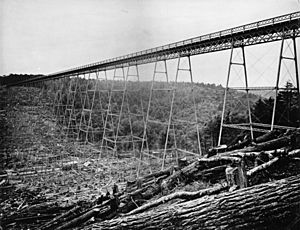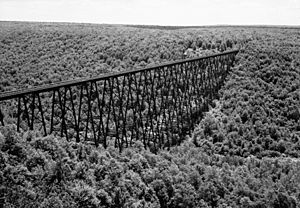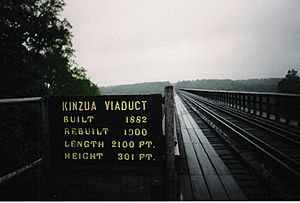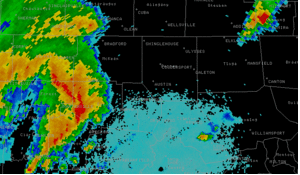Kinzua Bridge facts for kids
Quick facts for kids Kinzua Bridge |
|
|---|---|

The bridge before its collapse
|
|
| Coordinates | 41°45′40″N 78°35′19″W / 41.76111°N 78.58861°W |
| Crosses | Kinzua Creek |
| Locale | McKean, Pennsylvania, United States |
| Other name(s) | Kinzua Viaduct |
| Named for | Kinzua, Seneca for "fish on a spear" |
| Maintained by | Pennsylvania Department of Conservation and Natural Resources |
| Characteristics | |
| Design | Railroad bridge |
| Total length | 2,052 ft (625 m) |
| Width | 10 ft (3.0 m) |
| Height | 301 ft (92 m) |
| History | |
| Constructed by | Elmira Bridge Company |
| Collapsed | July 21, 2003 |
| NRHP reference No. | 77001511 |
| Added to NRHP | August 29, 1977 |
| Lua error in Module:Location_map at line 420: attempt to index field 'wikibase' (a nil value). | |
The Kinzua Bridge, also known as the Kinzua Viaduct, was a huge trestle bridge. It carried railroad tracks across Kinzua Creek in McKean County, Pennsylvania. This amazing bridge was 301 feet (92 m) tall and 2,052 feet (625 m) long. Sadly, most of it collapsed during a powerful tornado in July 2003.
The bridge was first built in 1882 from wrought iron. People called it the "Eighth Wonder of the World". For two years, it was the tallest railroad bridge on Earth! In 1900, the bridge was taken apart and rebuilt using stronger steel. This allowed it to hold much heavier trains. It was used by trains until 1959. Then, in 1963, the state of Pennsylvania bought it. It became the main attraction of a state park.
Workers started fixing the bridge in 2002. But before they could finish, a tornado hit in 2003. A large part of the bridge fell down. Old, rusty bolts holding the bridge to its base broke. This caused the collapse. Before it fell, the Kinzua Bridge was the fourth-tallest railway bridge in the United States. It was listed as a historic place in 1977. It was also named a National Historic Civil Engineering Landmark in 1982. Today, the remains of the Kinzua Bridge are in Kinzua Bridge State Park. You can find it near Mount Jewett, Pennsylvania.
Contents
Building the First Kinzua Bridge
In 1882, Thomas L. Kane had a big problem. He was the president of the New York, Lake Erie and Western Railway. He needed to build a new train line in Pennsylvania. This line would go from Bradford to the coal fields in Elk County. The quickest way was to build a bridge over the Kinzua Valley. Building a bridge was much easier than laying 8 miles (13 km) of track over rough land. When it was finished, the Kinzua Bridge was bigger than any bridge ever built. It was twice as large as the next biggest bridge at that time.
Forty workers built the first Kinzua Bridge. They used 1,552 short tons (1,408 t) of wrought iron. It took them only 94 working days! They worked from May 10 to August 29, 1882. They built it so fast because they did not use scaffolding. Instead, they used a special crane called a gin pole. This pole helped them build the first tower. Then, they put a traveling crane on top of that tower. They used it to build the next tower. They repeated this process for all 20 towers.
An engineer named Octave Chanute designed the bridge. The Phoenix Iron Works built it. This company made special hollow iron tubes. People often thought the bridge was made of wood because of these tubes. The bridge had 110 stone supports called piers. These were made from sandstone taken from the nearby hillside. The tallest tower was 193 feet (59 m) wide at its base. The bridge was made to hold 266 short tons (241 t) of weight. It cost between $167,000 and $275,000 to build.
When it was finished, the Kinzua Bridge was the tallest and longest railroad bridge in the world. It was called the "Eighth Wonder of the World". Six of its 20 towers were taller than the Brooklyn Bridge. People would travel from far away just to ride a train across it. The bridge held the height record until 1884. That's when the Garabit Viaduct, 401 feet (122 m) tall, was finished in France. Trains had to go very slowly, only 5 miles per hour (8.0 km/h), when crossing the bridge. This was because the train and wind made the bridge shake. Some people even visited the bridge hoping to find hidden treasure. A bank robber supposedly hid $40,000 in gold and money nearby.
Rebuilding the Bridge with Steel
By 1893, the railway company that owned the bridge went out of business. The Erie Railroad took over the bridge. By the early 1900s, train engines were much heavier. The old iron bridge could no longer safely carry them. The last train crossed the old bridge on May 14, 1900. Workers started taking the iron bridge apart on May 24.
C.R. Grimm designed the new bridge. The Elmira Bridge Company built it using 3,358 short tons (3,046 t) of steel. It cost $275,000. Construction began on May 26, starting from both ends of the old bridge. A team of 100 to 150 workers built the new steel frame. They worked 10-hour days for almost four months. They used two large "timber travelers" to build the towers. Each traveler was 180 feet (50 m) long. They were supported by two of the old iron towers. After a middle tower was removed, a new steel one was built. Then the traveler moved to the next section. Building each new tower took one week. The bolts that held the towers to the ground were reused from the first bridge. This was a big mistake, as Grimm later admitted.
The Kinzua Viaduct reopened on September 25, 1900. The new steel bridge could safely hold very large steam locomotives. Even the 511-short-ton (464 t) Big Boy could cross it. The Erie Railroad had a small station at the bridge. It was built between 1911 and 1916.
Train crews sometimes played a trick on new workers. When the train was close to the bridge, they would send a new brakeman to check a fake problem on the train's roof. As the train crossed the bridge, the new worker would suddenly be terrified. They would be staring down three hundred feet (90 m) from the rocking train car! Even after being rebuilt, the bridge still had a speed limit of 5 miles per hour (8 km/h). As the bridge got older, heavy trains with two steam engines had to stop. The engines would cross the bridge one at a time. Diesel locomotives were lighter and did not have this problem. The last steam train crossed the bridge on October 5, 1950.
In the late 1950s, the Erie Railroad found a way to use tracks from another company. This let them avoid the aging Kinzua Bridge. Regular train service ended on June 21, 1959. The Erie Railroad sold the bridge to the Kovalchick Salvage Company for $76,000. The bridge was used for one more day in October 1959. A train wreck on another line forced trains to use the Kinzua Bridge. The American Society of Civil Engineers said the bridge was very important. It helped transport coal from Pennsylvania to the Great Lakes. This helped the economy grow a lot.
Kinzua Bridge State Park
Nick Kovalchick, who owned the bridge, did not want to take it apart. He supposedly said, "There will never be another bridge like this." Kovalchick worked with local groups who wanted to save the bridge. On August 12, 1963, Pennsylvania Governor William Scranton signed a law. It allowed the state to buy the bridge and land for $50,000. This created Kinzua Bridge State Park. The park opened to the public in 1970.
A road to the park was built in 1974. New things were added, like a parking lot, water, and restrooms. A fence was put on the bridge deck. On July 5, 1975, there was a special ceremony for the park. It was unique because its main feature was a man-made structure. The bridge was added to the National Register of Historic Places in 1977. It was also named a National Historic Civil Engineering Landmark in 1982.
The Knox and Kane Railroad (KKRR) offered sightseeing trips. From 1987 until 2002, trains went from Kane over the Kinzua Bridge. In 1988, they ran the longest steam train trip in the United States. It was a 97-mile (156 km) round trip to the bridge. The New York Times said being on the bridge felt "more like ballooning than railroading". You could see a huge green valley 91 metres (299 ft) below. The railroad stopped its trips in October 2004.
Today, Kinzua Bridge State Park is 329-acre (133 ha). It surrounds the bridge and the Kinzua Valley. The park is north of Mount Jewett. A special viewing area in the park lets you see the fallen bridge and the valley. It's a great place to see the beautiful fall colors. The park has a shaded picnic area with restrooms. Before the bridge collapsed, visitors could walk on or under it. Hiking was also allowed in the valley. In September 2002, the bridge was closed to everyone. About 100 acres (40 ha) of the park is open for hunting. You might find turkey, bear, and deer there.
The Bridge's Destruction
Since 2002, the Kinzua Bridge was closed to all visitors and trains. Engineers found that strong winds could make the bridge unsafe. They realized that high winds could shift the bridge's weight. This could make it fall. A company from Ohio started working to fix the bridge in February 2003.
On July 21, 2003, construction workers were leaving for the day. A big storm arrived. A tornado from the storm hit the Kinzua Bridge. It broke and pulled up nearby trees. It also caused 11 of the 20 bridge towers to collapse. Luckily, no one was hurt. The tornado was part of a large group of strong thunderstorms. This storm formed over Ohio, Pennsylvania, New York, and Ontario. It moved east at about 40 miles per hour (60 km/h). As it crossed Pennsylvania, it formed a special comma shape. The northern part of the storm had a long-lasting rotating updraft. This kind of storm often creates tornadoes.
Around 3:20 PM EDT, the tornado touched down in Kinzua Bridge State Park. It was 1 mile (1.6 km) from the bridge. The tornado was an F1 on the Fujita scale. It passed the bridge and traveled another 2.5 miles (4 km) before lifting. It touched down again 2 miles (3 km) from Smethport. It traveled another 3 miles (4.8 km) before finally disappearing. It was about 1⁄3-mile (540 m) wide and left a path 3.5 miles (5.6 km) long. The same storm also caused a stronger F3 tornado in nearby Potter County.
When the tornado hit, winds reached at least 94 miles per hour (151 km/h). The wind came from the east, hitting the bridge sideways. An investigation found that Towers 10 and 11 fell first. They fell towards the west. Towers 12 through 14 were actually lifted off their bases. They moved a little to the northwest and then landed back upright. They were held together only by the train tracks. Then, towers four through nine fell to the west, twisting clockwise. This happened as the tornado moved north. As the tornado moved, winds from the south caused Towers 12, 13, and 14 to finally fall north. They twisted counterclockwise.
The bridge fell because the old, rusty bolts at the base of the towers broke. These bolts held the towers to concrete blocks in the ground. The investigation found that the tornado's wind speed was at least 94 miles per hour (151 km/h). This put about 90 short tons-force (800 kN) of sideways force on the bridge. The investigation also thought the whole bridge swayed back and forth four or five times. This caused the base bolts to break from stress. The century-old bridge was destroyed in less than 30 seconds.
What Happened Next
The state decided not to rebuild the Kinzua Bridge. It would have cost about $45 million. Instead, they decided to use the ruins as a visitor attraction. This would show how powerful nature can be. Kinzua Bridge State Park used to get 215,000 visitors each year before the bridge fell. It was chosen as one of Pennsylvania's "Twenty Must-See State Parks". The bridge and its collapse were shown on the History Channel's Life After People. It was an example of how rust and strong winds can destroy steel structures. The bridge was removed from the National Register of Historic Places on July 21, 2004.
The Knox and Kane Railroad had to stop its train trips in October 2004. The number of passengers dropped by 75 percent. This was likely because the Kinzua Bridge had collapsed. The Kovalchick Corporation bought the Knox and Kane's tracks and other property. This company also owned the Kinzua Bridge before selling it to the state in 1963. In 2008, the company announced plans to remove the tracks. They would sell them for scrap metal. The land where the tracks were would then become a rail trail for walking and biking.
Pennsylvania released $700,000 in June 2005. This money was to design repairs for the remaining towers. It was also for planning new park facilities. In late 2005, the Pennsylvania Department of Conservation and Natural Resources (DCNR) suggested an $8 million plan. This plan included a new observation deck and visitors' center. It would also allow access to the bridge and a hiking trail. The trail would give views of the fallen towers. The Kinzua Sky Walk opened on September 15, 2011. It was opened with a special ceremony. The Sky Walk is a walkway that leads to an observation deck. This deck has a glass floor at the end of the bridge. It lets you see the bridge and the valley directly below. The walkway cost $4.3 million to build. But it is expected to bring in $11.5 million in tourism money for the area.
Images for kids








